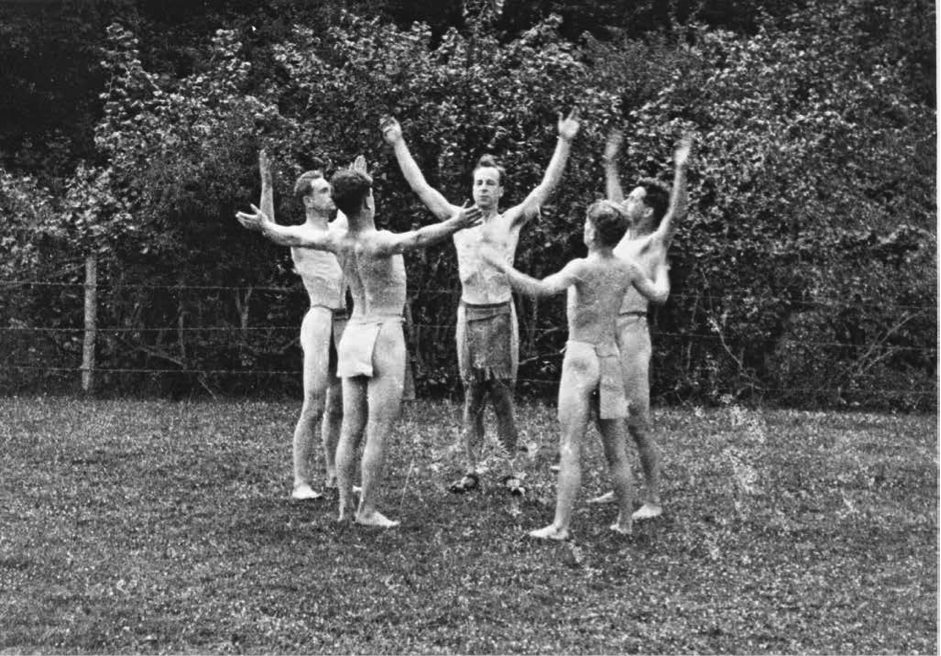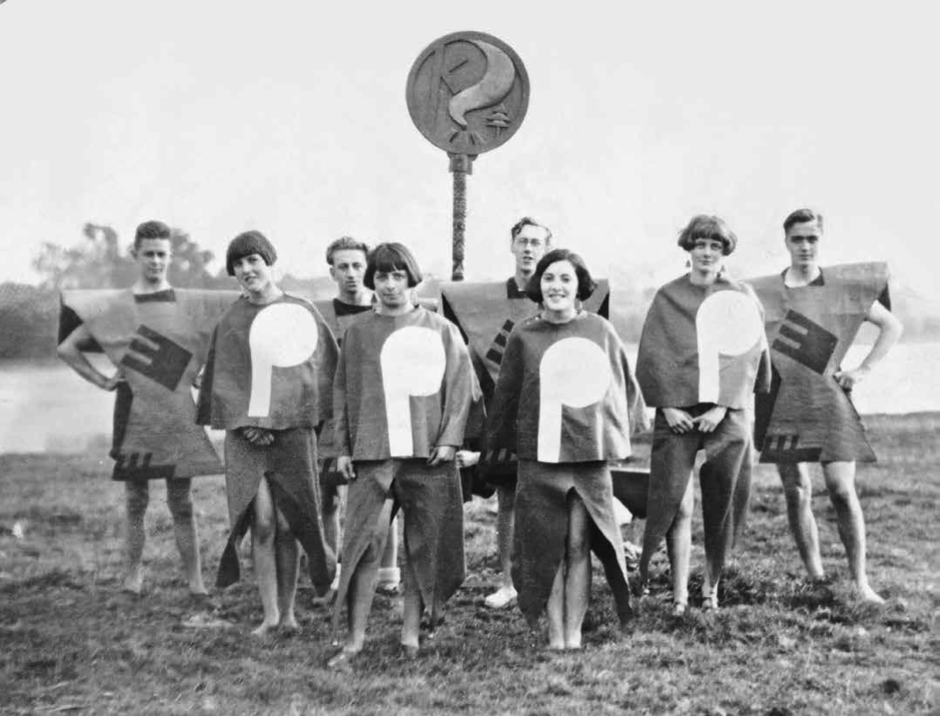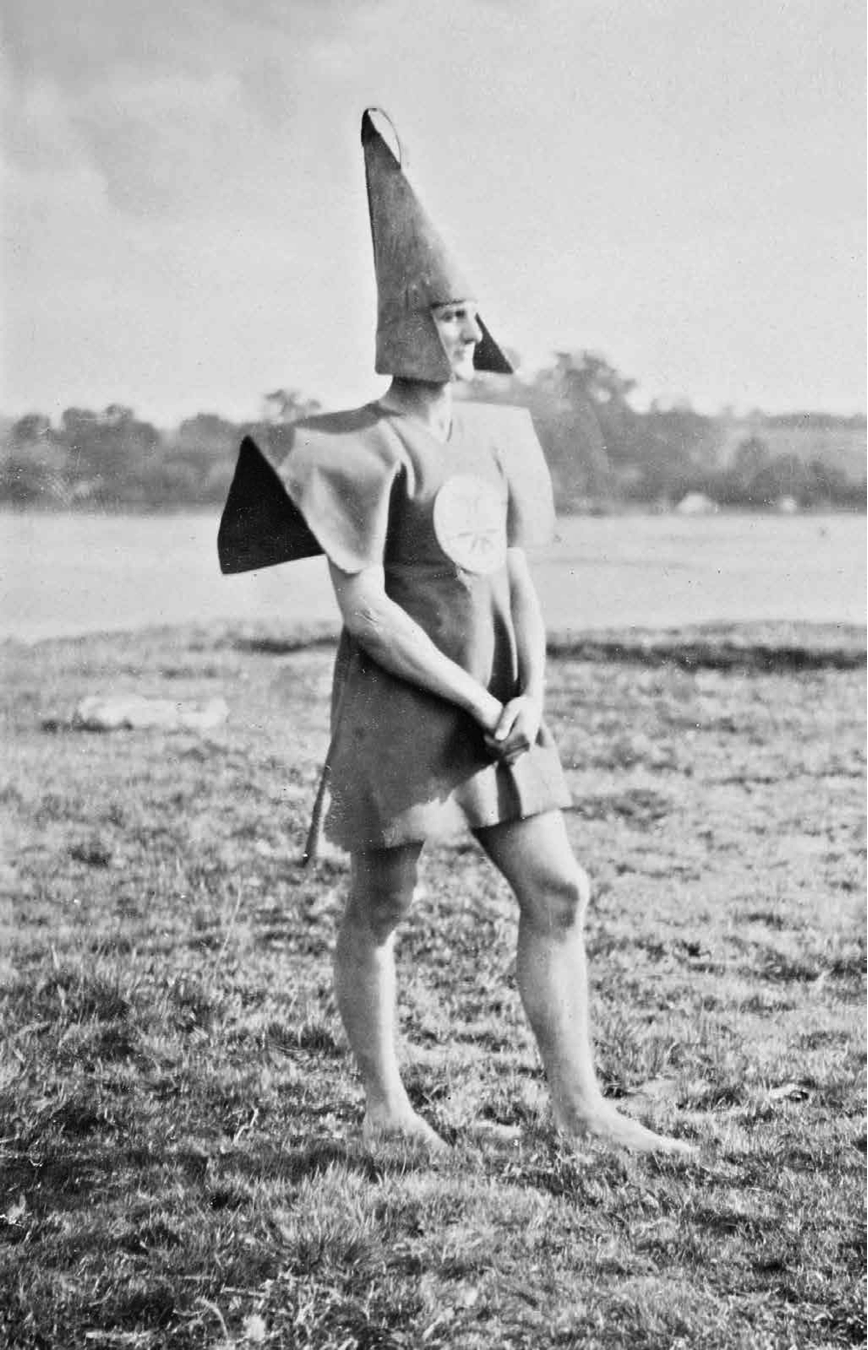IN 1920, A GROUP of youth leaders walked out of the Boy Scout movement in Britain, disillusioned with the increasing militarism of its methods. Led by the former scout commissioner and artist John Hargrave, the pacifists styled themselves as The Kindred of the Kibbo Kift, adapting a term from archaic Cheshire dialect meaning ‘proof of strength.’ This new, all-ages group promoted creative expression, physical health and fitness through camping, hiking and handicraft. They aimed to produce hard bodies and straight thinking as solutions to what they believed to be a civilisation in crisis in the wake of the First World War. Although largely forgotten now, during the 1920s Kibbo Kift’s ambitions and practices attracted the attention and endorsement of a range of high profile figures across the arts, humanities and sciences, from H. G. Wells to D. H. Lawrence. While membership numbers were small – never amounting to many more than a thousand in total – Kibbo Kift’s spiritual seekers, life reformers, educators and dreamers wished for nothing less than to fashion a new world, and they did so with the help of their dress and self-presentation.1

Radical intervention in sartorial appearance was a core part of Kibbo Kift’s project, and the group developed an original and idiosyncratic aesthetic across all aspects of their art, craft and design. Taking inspiration from the author and artist Ernest Thompson Seton’s theory of ‘woodcraft,’ as a form of outdoor living and naturalist educational training, Kibbo Kift’s leader believed in ‘picturesqueness in everything.’2 What the Kindred looked like mattered. This focus was not simply a surface issue; the group’s ambitions and vision were underpinned by an interest in aesthetic beauty and physical culture, which intersected with post-war concerns with fitness and reconstruction. From the outset, the group’s wide-ranging ambitions for world reform and peace were addressed in terms of reverence for the body, while group costume ranged from the practical to the dramatic. Flowing green hooded cloaks were worn for camping and hiking; skimpy exercise garments comprised brass brassiere tops for women and Native American-style breechcloths or ‘gee-strings’ for men. Each outfit had to be handmade by individual Kinsfolk to an original Hargrave design. This was a demonstration of practical self-reliance in craft as well as symbolic commitment to the cause.

In the group’s elaborate cultural activities, which included spiritual ritual as well as original theatre and song, ceremonial surcoats featured occult insignia and dramatic robotic silhouettes; performance costumes updated medieval jesters’ outfits with avant-garde elements. In these elements of Kibbo Kift’s wardrobe, the group’s spiritual and aesthetic influences, from hermetic religion to cutting-edge advertising, were made clear. The outfits had to be uncompromising because radical sartorial action was required for total cultural transformation. Hargrave described conventional dress, such as the bowler hat, as ‘pathetic – a tragi-comedy – the headgear of purposeless routine. It is the symbol of frustration – physical, psychological, and religious. It is an inane thing. Similarly,’ he pronounced, ‘the waistcoat, coat and trousers are the livery of a particular form of slavery.’3 Kibbo Kift’s outlandish and sometimes self-consciously ridiculous costuming communicated the group’s radical distinctiveness and their wholesale rejection of ‘civilised’ culture. Through dress that liberated the body and that adopted elements from the past as well as the future, Kibbo Kift aimed to show the redundancy of the present day and its finery, in order to enact the next stage of cultural evolution.

The Kindred were not alone in their ambition to reform dress practices in the period. The Men’s Dress Reform Party, established in 1929, featured several prominent Kibbo Kift members who were active in its ambitions for more colour and comfort in dress for the modern male. Although this endeavour generated some public ridicule, the MDRP sought to do away with neckties and stiff collars, adopting scouting-style shorts for everyday wear to improve ‘hygiene’ in clothing and to reflect increasing informality of behaviour.4 The restrictions and impracticalities of women’s clothes had also long been subject to critique by health campaigners and dress reformers and Kibbo Kift members also added to these debates throughout the 1920s. While Kibbo Kift cultivated drama in dress, comfort and practicality were always emphasised over fashionable silhouettes and frivolous fabrics. As part of Hargrave’s ambitions to correct what he saw as an increasingly unnatural existence, he placed significant emphasis on the natural human form as a foundation for a healthy society, unfavourably comparing the constrained gait of a ‘civilised’ woman with the physical perfection of animal movement, for example. These ideas about the apparently inherent superiority of the natural world drew on biologist Herbert Spencer’s assertion that ‘to be a nation of good animals is the first condition of national prosperity.’ This phrase was a familiar one within experimental health and physical culture circles in the interwar period, for Kibbo Kift was not alone in its interest in cultural and physical regeneration in Britain. Bodily beauty and fitness were widely perceived in moral terms as an index of the state of the nation.5

The role of beauty in the Kibbo Kift was linked not only to their ideals for dress reform but also to their particular approach to gender and sexuality. Advice given to girls and women – always by Kibbo Kift men, even if the subject was menstruation or contraception – was that they ‘should do their utmost to be attractive, well dressed, and graceful.’6 Kinswomen were expected to hike long distances, carry heavy packs, wear stout shoes and suffer the same improving hardships as men, but they needed to do so in a dress and stockings (a motion that Kinswomen should be permitted to wear green, brown or grey ‘rational dress,’ that is, trousers, was passed at the 1924 annual gathering but was never enacted). Despite the group’s radical approach to dressing, they had conformist attitudes to sex roles and relationships. Heterosexual, monogamous partnerships were strongly encouraged alongside early marriage and childbearing. Women and men were expected to inhabit their assigned roles as active and passive sexual ‘polarities.’ These gendered ideas played out in the leadership roles in the organisation and consequently affected directions about appearance, where Kinswomen were instructed to appear ‘free, natural, unconventional,’ but never ‘mannish.’7

Although the group was open to all ages, like many outdoor movements and societies across Europe in the early years of the twentieth century, Kibbo Kift promoted the virility and vitality of youth. From 1929, two specially designed Kibbo Kift leather belts were commissioned from Liberty’s of London, where two of the central Kin members were employed. These featured ornate Celtic-styled buckles in silver, embedded with K symbols and semi-precious jewels. Each was engraved with the archaic message, ‘Wes Hael! Be thou whole in body-fastness.’ As a celebration of physical health and spiritual wholeness, these were presented annually to the fittest young man and woman of the Kin.8 Images of the recipients were published in Broadsheet, the Kibbo Kift magazine. Nietzschean ideas about human perfectibility, with Kinsfolk as the embodiment of the superman ideal, were sometimes denied in Kin literature, but they undoubtedly underpinned much of Kibbo Kift’s thinking about bodily beauty and sexual behaviour.9
Kibbo Kift’s concerns with physical fitness, the cultivation of natural beauty and the propagation of a new, healthy generation echo some aspects of the eugenic ideal in the early decades of the twentieth century, which circulated among a wide range of reformers across the political spectrum in search of social betterment.10 There is a tendency to read such ideals retrospectively through their later development in the hands of national fascist regimes but it is important to view the ideas in their localised cultural contexts. Like many of their peers in the 1920s, the Kindred of the Kibbo Kift were concerned about physical degeneration in the wake of the First World War but they aimed to solve the problems themselves through positive interventions at the level of their own bodies. Kibbo Kift’s dance and drama, hikes and handicrafts were intended to foster physical strength and clarity of mind as qualities that would be required by those who wished to survive the expected cultural collapse. In designing a new world from the bottom up, Kinsfolk’s bodies and dress provided privileged sites onto which dramatic new dreams and retro-futurist fantasies could be projected.
Annebella Pollen is Principal Lecturer in the History of Art and Design at the University of Brighton. She is the author of The Kindred of the Kibbo Kift: Intellectual Barbarians, published by Donlon Books, and the co-curator, with Nayia Yiakoumaki, of the exhibition ‘Intellectual Barbarians: The Kibbo Kift Kindred’, which runs at Whitechapel Gallery, London until 13 March 2016.
For a full discussion of Kibbo Kift’s purpose and philosophy, from founding to decline, see A Pollen, The Kindred of the Kibbo Kift: Intellectual Barbarians, Donlon Books, London, 2015. ↩
Seton first set out his nine woodcraft principles in 1910; this quote is taken from his summary of thirty years of woodcraft training: E Thompson Seton, Woodcraft and Indian Lore, Doubleday, Doran and Company, London, 1930, p. 7. ↩
J Hargrave. The Confession of the Kibbo Kift, William Maclellan, Glasgow, 1979 [1st ed. 1927], p. 99. ↩
For more on men’s dress reform, see J Bourke, ‘The Great Male Renunciation: Men’s Dress Reform in Inter-War Britain’, Journal of Design History, 9.1, 1996, pp. 23–33; also I Zweiniger-Bargielowska, Managing the Body: Beauty, Health and Fitness in Britain, 1880–1939, Oxford University Press, Oxford, 2010. ↩
I Zweiniger-Bargielowska, ‘Raising a Nation of “Good Animals”: The New Health Society and Health Education Campaigns in Interwar Britain’, Social History of Medicine, 20.1, 2007, pp. 73–89. ↩
J Hargrave. ‘The Women of the Kindred’, Broadsheet [Kibbo Kift magazine], 28, November 1927, p. 3. ↩
‘An Outline of Kibbo Kift Training: The Woman’, Nomad [Kibbo Kift magazine], 1:11, April 1924, pp. 128–129. ↩
The belts can be seen in the exhibition, Intellectual Barbarians: The Kibbo Kift Kindred, Whitechapel Gallery, London, until March 2016. ↩
F W Nietzsche, Thus Spoke Zarathustra, Penguin Books, London, 2003. ↩
For contextual literature on eugenic concerns, see L Bland and L A Hall, ‘Eugenics in Britain: The View from the Metropole’, The Oxford Handbook of the History of Eugenics, edited by A Bashford and P Levine, Oxford University Press, Oxford, 2010; also R Overy, The Morbid Age: Britain and the Crisis of Civilization, 1919-1939, Penguin, London, 2009. ↩